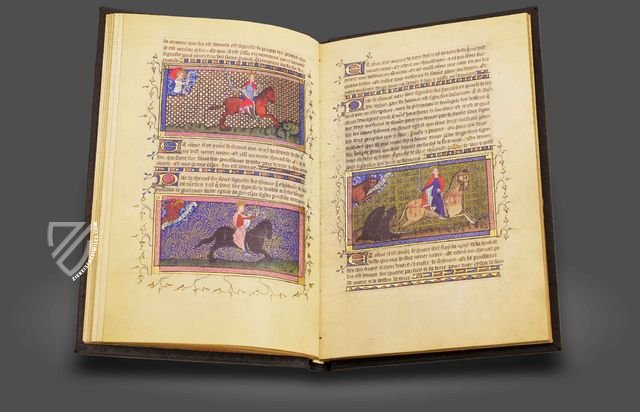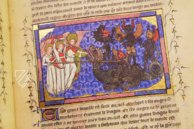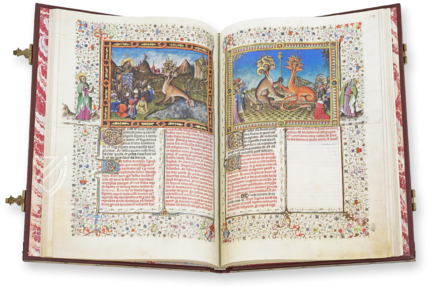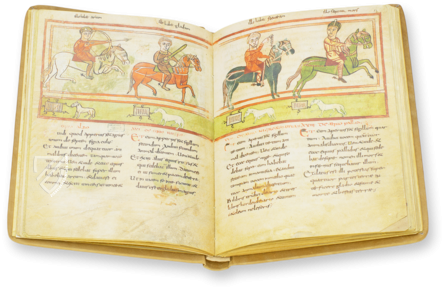The Golden Images of the Apocalypse
(1,000€ - 3,000€)
Sometime between 1370 and 1390, a precious and elaborately-designed Apocalypse manuscript arose in France. This text is the Golden images of the Apocalypse, which is named after its last owner, Henry Yates Thompson. Only very little information exists about the mysterious work. Its splendid, brightly colored miniatures in the French Gothic style were made by the same master, who was already responsible for the design of the famous Coronation Book of Charles V.
The Golden Images of the Apocalypse
The Revelation of John, also known as the Apocalypse, is the last book of the New Testament. The tale of the end of the world and Judgement Day belongs among the most influential literary works worldwide and has been continuously adapted in literature, film, or in the visual arts. A particularly interesting edition of the biblical text is found today in the collection of the Briton Henry Yates Thompson. The origin story of the Apocalypse Yates Thompson continues to be a riddle for researchers and historians. The thrilling manuscript is illustrated with 69 large miniatures, golden initials and floral bordures.
The Path of the Mysterious Work
Only very little is known for sure about the Apocalypse Yates Thompson, whose name comes from its last owner, Henry Yates Thompson. It is not known who commissioned the precious manuscript. However, numerous sources verify the various places where the codex resided in the course of history. Its first owner was Jean Philipp Eugène von and zu Meroda, Margrave of Westerlo, and the Imperial Count of Brussels. The Imperial Count, who came from the upper nobility of Merode, was a Knight of the Order of the Golden Fleece since 1694 and was named Imperial Field Marshall in 1717. Numerous precious illuminated manuscripts were in the private collection of the nobleman. Later, ca. 1844, the manuscript was listed in the inventory of Augustus Frederick, the Duke of Sussex. After passing through various locations, the mysterious manuscript made its way to British newspaper tycoon and book collector Henry Yates Thompson at the beginning of the 20th century. He bequeathed the work along with the rest of his considerable library to the British Library in London after his death.
Precious Late-Gothic Illumination
The Apocalypse Yates Thompson was most-likely produced by the same master who was also responsible for the design of the Coronation Book of Emperor Charles V. The anonymous book artist decorated the manuscript with large, historiated initials that shimmer in a luminous wealth of colors and precious gold elements. The numerous miniatures illustrating the text completely retain the French Gothic style. The terrifying events of John’s vision of the end of the world, which fascinated Christians from across the world for centuries, are depicted in a charmingly original surface painting style. The depictions show pictures of Judgement Day, of monsters and wild beasts, of angels and heavenly creatures. The fantasy of the anonymous illuminator, who so skillfully staged the biblical story, was boundless.
Codicology
- Alternative Titles
- Die goldenen Bilder der Apokalypse
Apocalypsis Yates Thompson 10
Yates Thompson Apocalypse - Size / Format
- 80 pages / 26.5 × 18.2 cm
- Origin
- France
- Date
- Ca. 1370–1390
- Epochs
- Style
- Genre
- Language
- Script
- Gothic Textura Rotunda
- Illustrations
- 69 large miniatures; 1 historiated inital; gilded initials and floral borders troughout
- Content
- Book of Revelation, prologue and commentary
- Artist / School
- Attributed to the artist responsible for the Coronation Book of Charles V (Cotton Tiberius B VIII, ff. 35-80, British Library, London) executed in Paris in 1365.
- Previous Owners
- Jean Philippe Eugène (1674–1732), count of Merode, marquis of Westerloo
Augustus Frederick (1801–1843), Duke of Sussex
Thomas Thorpe
John Fuller Russell
Henry Yates Thompson (1838–1928)
Henry Yates Thompson, re-acquired by 1926.
Bequeathed to the British Museum in 1941 by Mrs. Henry Yates Thompson.
The Golden Images of the Apocalypse
The Lake of Fire
In this Gothic miniature, the Heavenly Host is victorious: “Then the beast was captured, and with him the false prophet who worked signs in his presence, by which he deceived those who received the mark of the beast and those who worshiped his image. These two were cast alive into the lake of fire burning with brimstone. And the rest were killed with the sword which proceeded from the mouth of Him who sat on the horse. And all the birds were filled with their flesh”. (Rev. 19:20-21)

The Golden Images of the Apocalypse
The Lamb on Mount Zion
The Seven Spiritual Figures are counted among the enigmatic characters that appear in the Book of Revelation leading up to the Third Woe, the last of which is a lamb: “Then I looked, and behold, a Lamb standing on Mount Zion, and with Him one hundred and forty-four thousand, having His Father’s name written on their foreheads” (Rev 14:1).
Although the lamb is one of the more famous Christian icons to represent God through the sacrifice of his son, the 144,000 are more enigmatic. These are the so-called “first fruits”, the initial group of the faithful who are redeemed and emerge victorious over the Beast, his mark, and his image. Dressed in red and blue, they appear with serene faces and hands devoutly folded in front of them as they gather around Mount Zion.

#1 Apocalypsis Yates Thompson 10
Languages: English, Spanish
(1,000€ - 3,000€)
- Treatises / Secular Books
- Apocalypses / Beatus
- Astronomy / Astrology
- Bestiaries
- Bibles / Gospels
- Chronicles / History / Law
- Geography / Maps
- Saints' Lives
- Islam / Oriental
- Judaism / Hebrew
- Single Leaf Collections
- Leonardo da Vinci
- Literature / Poetry
- Liturgical Manuscripts
- Medicine / Botany / Alchemy
- Music
- Mythology / Prophecies
- Psalters
- Other Religious Books
- Games / Hunting
- Private Devotion Books
- Other Genres
- Afghanistan
- Armenia
- Austria
- Belgium
- Colombia
- Croatia
- Cyprus
- Czech Republic
- Denmark
- Egypt
- Ethiopia
- France
- Germany
- Greece
- Hungary
- India
- Iran
- Iraq
- Israel
- Italy
- Japan
- Lebanon
- Luxembourg
- Mexico
- Morocco
- Netherlands
- Palestine
- Peru
- Poland
- Portugal
- Russia
- Serbia
- Spain
- Sri Lanka
- Sweden
- Switzerland
- Syria
- Turkey
- Ukraine
- United Kingdom
- United States
- Uzbekistan
- Aboca Museum
- Ajuntament de Valencia
- Akademie Verlag
- Akademische Druck- u. Verlagsanstalt (ADEVA)
- Aldo Ausilio Editore - Bottega d’Erasmo
- Alecto Historical Editions
- Alkuin Verlag
- Almqvist & Wiksell
- Amilcare Pizzi
- Andreas & Andreas Verlagsbuchhandlung
- Archa 90
- Archiv Verlag
- Archivi Edizioni
- Arnold Verlag
- ARS
- Ars Magna
- ArtCodex
- AyN Ediciones
- Azimuth Editions
- Badenia Verlag
- Bärenreiter-Verlag
- Belser Verlag
- Belser Verlag / WK Wertkontor
- Benziger Verlag
- Bernardinum Wydawnictwo
- BiblioGemma
- Biblioteca Apostolica Vaticana (Vaticanstadt, Vaticanstadt)
- Bibliotheca Palatina Faksimile Verlag
- Bibliotheca Rara
- Boydell & Brewer
- Bramante Edizioni
- Bredius Genootschap
- Brepols Publishers
- British Library
- C. Weckesser
- Caixa Catalunya
- Canesi
- CAPSA, Ars Scriptoria
- Caratzas Brothers, Publishers
- Carus Verlag
- Casamassima Libri
- Chavane Verlag
- Christian Brandstätter Verlag
- Circulo Cientifico
- Club Bibliófilo Versol
- Club du Livre
- CM Editores
- Collegium Graphicum
- Collezione Apocrifa Da Vinci
- Comissão Nacional para as Comemorações dos Descobrimentos Portugueses
- Coron Verlag
- Corvina
- CTHS
- D. S. Brewer
- Damon
- De Agostini/UTET
- De Nederlandsche Boekhandel
- De Schutter
- Deuschle & Stemmle
- Deutscher Verlag für Kunstwissenschaft
- DIAMM
- Droz
- E. Schreiber Graphische Kunstanstalten
- Ediciones Boreal
- Ediciones Grial
- Ediclube
- Edições Inapa
- Edilan
- Editalia
- Edition Deuschle
- Edition Georg Popp
- Edition Leipzig
- Edition Libri Illustri
- Editiones Reales Sitios S. L.
- Éditions de l'Oiseau Lyre
- Editions Medicina Rara
- Editorial Casariego
- Editorial Mintzoa
- Editrice Antenore
- Editrice Velar
- Edizioni Edison
- Egeria, S.L.
- Eikon Editores
- Electa
- Emery Walker Limited
- Enciclopèdia Catalana
- Eos-Verlag
- Ephesus Publishing
- Ernst Battenberg
- Eugrammia Press
- Extraordinary Editions
- Fackelverlag
- Facsimila Art & Edition
- Facsimile Editions Ltd.
- Facsimilia Art & Edition Ebert KG
- Faksimile Verlag
- Feuermann Verlag
- Folger Shakespeare Library
- Franco Cosimo Panini Editore
- Friedrich Wittig Verlag
- Fundación Hullera Vasco-Leonesa
- G. Braziller
- Gabriele Mazzotta Editore
- Gebr. Mann Verlag
- Gesellschaft für graphische Industrie
- Getty Research Institute
- Giovanni Domenico de Rossi
- Giunti Editore
- Graffiti
- Grafica European Center of Fine Arts
- Guido Pressler
- Guillermo Blazquez
- Gustav Kiepenheuer
- H. N. Abrams
- Harrassowitz
- Helikon
- Hendrickson Publishers
- Henning Oppermann
- Herder Verlag
- Hes & De Graaf Publishers
- Hoepli
- Holbein-Verlag
- Hortus Deliciarum
- Houghton Library
- Hugo Schmidt Verlag
- Idion Verlag
- Il Bulino, edizioni d'arte
- ILte
- Imago
- Insel Verlag
- Instituto Nacional de Antropología e Historia
- Istituto dell'Enciclopedia Italiana - Treccani
- Istituto Ellenico di Studi Bizantini e Postbizantini
- Istituto Geografico De Agostini
- Istituto Poligrafico e Zecca dello Stato
- Italarte Art Establishments
- J. Thorbecke
- Jan Thorbecke Verlag
- Johnson Reprint Corporation
- Josef Stocker
- Josef Stocker-Schmid
- Jugoslavija
- Karl W. Hiersemann
- Kasper Straube
- Kaydeda Ediciones
- Kindler Verlag / Coron Verlag
- Kodansha International Ltd.
- Konrad Kölbl Verlag
- Kurt Wolff Verlag
- La Liberia dello Stato
- La Linea Editrice
- La Meta Editore
- Lambert Schneider
- Landeskreditbank Baden-Württemberg
- Leo S. Olschki
- Les Incunables
- Library of Congress
- Libreria Musicale Italiana
- Lichtdruck
- Lito Immagine Editore
- Lumen Artis
- Lund Humphries
- M. Moleiro Editor
- Maison des Sciences de l'homme et de la société de Poitiers
- Manuscriptum
- Martinus Nijhoff
- Maruzen-Yushodo Co. Ltd.
- MASA
- McGraw-Hill
- Militos
- Millennium Liber
- Müller & Schindler
- Nahar and Steimatzky
- National Library of Wales
- Neri Pozza
- Nova Charta
- Oceanum Verlag
- Odeon
- Orbis Mediaevalis
- Orbis Pictus
- Österreichische Staatsdruckerei
- Oxford University Press
- Pageant Books
- Parzellers Buchverlag
- Patrimonio Ediciones
- Pattloch Verlag
- PIAF
- Pieper Verlag
- Plon-Nourrit et cie
- Prestel Verlag
- Princeton University Press
- Prisma Verlag
- Priuli & Verlucca, editori
- Pro Sport Verlag
- Propyläen Verlag
- Pytheas Books
- Quaternio Verlag Luzern
- Reales Sitios
- Recht-Verlag
- Reichert Verlag
- Reichsdruckerei
- Riehn & Reusch
- Roberto Vattori Editore
- Rosenkilde and Bagger
- Roxburghe Club
- Salerno Editrice
- Sarajevo Svjetlost
- Schöck ArtPrint Kft.
- Scolar Press
- Scrinium
- Scripta Maneant
- Scriptorium
- Siloé, arte y bibliofilia
- SISMEL - Edizioni del Galluzzo
- Sociedad Mexicana de Antropología
- Société des Bibliophiles & Iconophiles de Belgique
- Soncin Publishing
- Sorli Ediciones
- Stainer and Bell
- Studer
- Styria Verlag
- Sumptibus Pragopress
- Szegedi Tudomànyegyetem
- Taberna Libraria
- Tarshish Books
- Taschen
- Tempus Libri
- Testimonio Compañía Editorial
- Thames and Hudson
- The Clear Vue Publishing Partnership Limited
- The Facsimile Codex
- The Folio Society
- The Marquess of Normanby
- The Richard III and Yorkist History Trust
- Tip.Le.Co
- TouchArt
- TREC Publishing House
- TRI Publishing Co.
- Trident Editore
- Typis Regiae Officinae Polygraphicae
- Union Verlag Berlin
- Universidad de Granada
- University of California Press
- University of Chicago Press
- Urs Graf
- Vallecchi
- Van Wijnen
- VCH, Acta Humaniora
- VDI Verlag
- VEB Deutscher Verlag für Musik
- Verlag Anton Pustet / Andreas Verlag
- Verlag Bibliophile Drucke Josef Stocker
- Verlag der Münchner Drucke
- Verlag für Regionalgeschichte
- Verlag Styria
- Vicent Garcia Editores
- W. Turnowsky
- Waanders Printers
- Wiener Mechitharisten-Congregation (Wien, Österreich)
- Wissenschaftliche Buchgesellschaft
- Wydawnictwo Dolnoslaskie
- Xuntanza Editorial
- Zakład Narodowy
- Zollikofer AG









